How Do You Tie an Albright Knot


Toggle Menu
Fly Fishing Knots February 16, 2015 – Posted in: Instruction
Basic Knots for Fly Tackle
Scientific Anglers pioneered a concept that underlies all other decisions in fly tackle selection: The Balanced System. By this, we mean your tackle-rod, reel, line, leader and tippet should be balanced for better performance.
The Balanced System
You can easily select balanced components for your system because the fly tackle industry follows a common standard when labeling products. For example, most rod manufacturers label the proper line weight right on their rods, so that any 6-weight rod will balance with a 6-weight line. This is also true for most reels. No matter what quality rod, reel or line you buy, they won't perform properly if they aren't balanced. So check these components of your fly fishing system and make sure they are balanced before you assemble the rest of your system.
Before you start putting line on your reel, find out how much backing you'll need by reading your reel instructions. Then collect the components and spread them out on a flat surface with good lighting. A pair of nail clippers is the only tool you'll need to assemble them.
Even if you've done this before, you might want to spend a little extra time practicing the knots we recommend before you actually put the line on the reel. A leader, a piece of rope, or best of all, some old fly line make it easy to practice tying the knots you'll need to securely join the components of your system.
One other thing, most new reels are set up for left-handed retrieve, so if you reel from the right, you'll have to change the set up. This is usually a simple process and instructions should be found in the reel box.
The illustrations that follow show the easiest knots favored by experienced fly anglers.
The Basic Connections
The following diagram shows the basic fly fishing line connections and knots:
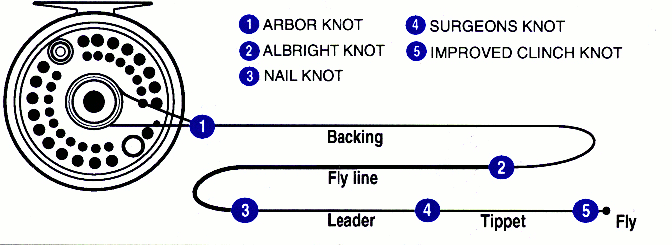
The Arbor Knot, to connect the Reel to the Backing
We strongly recommend you attach your fly line to backing, which goes on the reel spool first. Backing comes in different strengths, usually 20 lbs or 30 lbs. There are two ways to determine the right amount of backing to use. You can wind the line on first, followed by enough backing to fill within 1/8 to 3/16 inch from the edge of the spool. Then reverse the process. To avoid this extra step, many manufacturers include a chart with their reels that tells the proper amount of backing.
There are several good reasons for using backing. It lets your line form larger coils on the reel, which dramatically reduces line memory and also helps you wind your line more quickly. And, when you're playing big fish, the extra backing may save that fish when it makes a long run.
To assemble your tackle, many angers first fasten the fly reel to the reel seat of the rod. With the reel in place, the rod handle and stripper guide will help you wind on components more easily and efficiently. Pull off several feet of line from a spool of backing. Pass the tag end of the backing through the line guide closest to the rod handle. The most basic connection – anchoring backing to the reel arbor (or spool center) – uses the Arbor Knot.
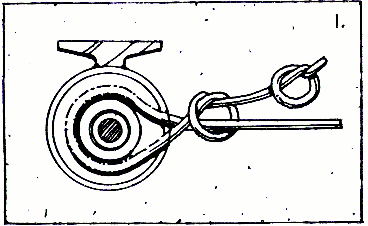
Tie an overhand knot on the backing end and tighten it. Insert this knotted end between the reel foot and the arbor, circle the arbor, and pull the knotted end out so it's next to the standing part of the backing. Tie a second overhand knot with the tag end around the standing part of the backing.
Holding the reel in your left hand, pull on the standing part of the backing with your right hand, snugging the knots against the arbor. Trip the tag end, and wind the backing onto your reel.
Make sure the line feeds from the guide on the rod to the bottom of the reel. If not, you're winding in the wrong direction. Make tight, smooth layers across the arbor as you wind on the proper amount of backing.
The next step is attaching the line to the backing and winding it onto the spool.
The Albright Knot, to connect the Backing to the Fly Line
Use the Albright Knot for tying backing to fly line.
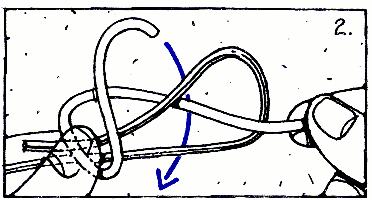
Unwind 2-3 feet of fly line from the plastic spool it came on (make sure you unwind the end marked "this end to reel").Start by doubling back a couple of inches of fly line and hold the loop with your left thumb and forefinger. From the right, insert about 10 inches of the backing through the fly line loop.
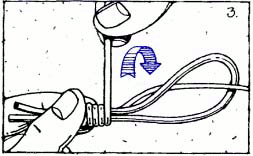
While holding the loop, pinch the backing between your left thumb and forefinger, and use your right hand to wrap the backing tag end back over both strands of the fly line and the backing.Start next to your fingers and working toward the loop end, make 10 to 12 fairly tight wraps.
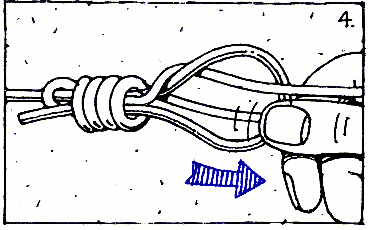
Push the tag end of the backing back through the loop on the side opposite where it originally entered so both backing strands exit on the same side of the loop. Pull on the standing part of the backing to remove the loop you where holding in your left hand. Pull both ends of the fly line backing.
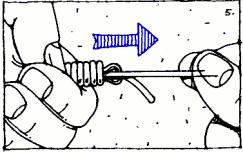
Pull gently on both ends of the fly line loop with your left hand; squeeze the knot with the fingers of your right hand and work it down to the loop end, but not off the fly line. Moisten the knot. Hold the standing and tag fly line strands in your left hand, and the tag and standing backing strands in your right hand. Pull as tight as possible. Clip off the tag end of the fly line and the backing.
You're now ready to wind the line over the backing onto the spool.
Here's where a friend can help by inserting a pencil through the hole in the line spool and holding it while you wind the line onto the reel spool under slight tension. Once the line is fully transferred to the reel spool, you should have approximately 3/16 inches between the line and the outside rim of the spool. As a final touch, put the pressure sensitive label, "Fly Line Marker," on the reel spool so you can always tell what line is on that spool.
The Nail Knot, to connect the Fly Line to the Leader
You may use the Albright Knot for the leader to line or a slightly more complicated, Nail Knot, can be used for a smoother finish. The Nail Knot requires a small diameter tube, such as the barrel of a ballpoint pen, a nail knot tool, or other similar object about twice the diameter of the fly line. Using a small diameter tube makes the knot easier to tie.
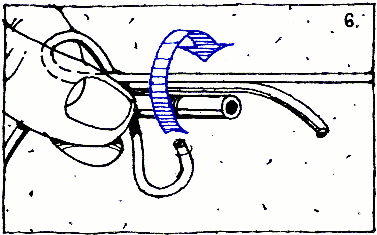
Hold the tube and the end of the fly line with your left thumb and forefinger so about two inches of the fly line and the tube sticks out to the right.
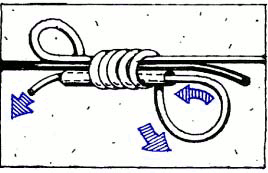
With your right hand, form a 2" loop in the heavier end of your leader. Pinch down and hold this loop with your left thumb and forefinger next to the tube and fly line.Use your right hand to grasp the short leg of the leader loop and make 5 snug wraps over the tube and fly line. These wraps should butt against each other, and be at least ½" to ¾" from the end of the fly line.Then slide your left thumb and forefinger forward to hold the wraps so they don't unwind while you work the tag end of the leader butt through the tube from right to left. Carefully remove the tube by sliding it to the left.S emi-tighten the knot by pulling gently on both ends of the leader. Don't pull on the fly line!
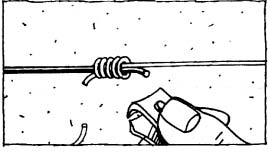
Moisten the knot area, inspect the knot wraps for smoothness, and tighten the knot by simultaneously pulling on both ends of the leader so it "bites" into the fly line. Then pull hard on the fly line and leader to "seat" the knot. Finally trim the leader tag end and the fly line end.
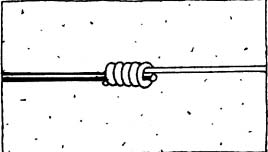
The Double Surgeon's Knot, to connect the Leader to the Tippet
The easiest and fastest knot for attaching the tippet to the leader in all kinds of conditions is the Double Surgeon's Knot.
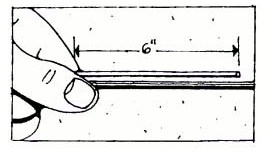
The Double Surgeon's Knot requires the leader and tippet to be placed side-by-side so they overlap (for about 6") with ends facing in opposite directions.Pinch the standing leader and tippet tag end with the left thumb and forefinger and use the right hand to tie an overhand knot with the leader tag end and the tippet.
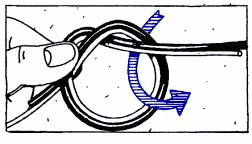
The entire length of the tippet must be passed completely through the overhand knot loop; even tough the leader tag end is only about 5" long. Don't tighten the completed overhand knot!
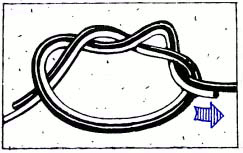
Grasp the completed loop with the left hand and make another pass through the same overhand knot, passing the full length of the tippet and the leader tag end through a second time.
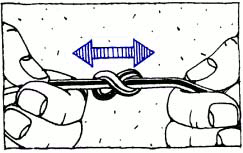
Draw the loop down by simultaneously pulling on leader and tippet. Moisten the loop; grasp the leader and tippet tag on the left with your left hand, and the tippet and leader tag on the right with your right hand. Pull all four ends simultaneously to snug the knot tight. Trim tag ends.
The Improved Clinch Knot, to connect the Tippet to the Fly
The final knot in putting your tackle together is the Improved Clinch Knot, which we recommend for tying a fly to your tippet. The turtle knot is also good. Insert 5" to 6" of tippet through the hook eye. Make five turns with the tag end around the standing part of the tippet, winding away from the hook.
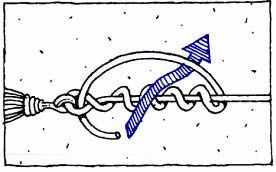
Push the tag end through the opening between the hook eye and the first wrap. This creates an open tippet loop over the wraps. Push the tag end through this open loop and pull slightly until the knot begins to close.
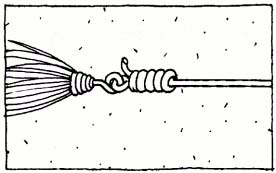
Moisten the knot area. Alternately pull on the standing portion of the tippet and the hook until the knot snugs up against the hook eye. Trim the tag end.
You have securely joined all the pieces of your tackle system – backing, line, leader, tippet and fly – and you have learned the basic knots of fly-fishing. The most important of these is the Improved Clinch Knot – the one you use to tie on your flies –because you will use it the most. So make sure you can do this one easily under any condition. Heavy winds, poor light and toughest of all, when that big fish is working the shallows!
Effective Knot-Tying
Few knots are 100% of the line's rated strength but if you moisten all knots before drawing them tight, tighten them slowly, and test every knot by pulling on it – hard – you will reduce the chance for knot failures. Be sure to replace leaders, tippets and lines when they show wear or abrasion. Never discard used monofilament anywhere but in a trash receptacle or recycling bin.
Fly Casting
With your balanced fly-fishing system in hand, there's one more thing to consider before heading off to your favorite waters. It has often been said, "The worst time to practice casting is when you're fishing." The excitement of working on feeding fish makes it pretty tough for most of us to do our best casting, let alone think about practicing! So get instruction and practice before you get into the field. They are the keys to success.
How Do You Tie an Albright Knot
Source: https://www.scientificanglers.com/fly-fishing-knot-tying-basics/
0 Response to "How Do You Tie an Albright Knot"
Post a Comment